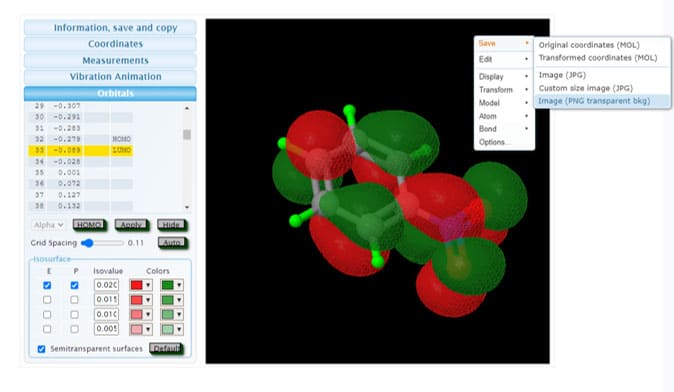
Instant Access to
Molecular
Orbitals
"For Over 4 Million Compounds"
Pre-Computed Molecular Orbital Insights at Your Fingertips.
Molecular orbital information is essential for unraveling the intricacies of chemical bonds and reactivity, deciphering spectroscopic data, driving groundbreaking pharmaceutical research, and propelling advancements in material science.
However, obtaining this crucial information necessitates complex quantum chemical calculations, which can be both laborious and time-consuming, requiring a strong understanding of theoretical concepts and expertise in specialized software tools.
Eliminate the hassle of performing quantum calculations. We have you covered. Our comprehensive database features high-quality quantum calculations for over 4 million chemical compounds, all available through our user-friendly online platform. Experience the convenience of instant access to molecular orbital information with just a few clicks.
Try Free Sample Compounds.
To explore our sample molecular orbital images and alpha and/or beta energy (MO energy) values, simply do
the followings
(View Video Guide):
-
1.
Navigate to our sample compounds page .
-
2.
Click one of the compound images (or click the “View our data” button).
- 3.
Click the “3D Visualization, Animation & Analysis” tab.
- 4.
Click “Orbitals” menu on the left side. A complete list of MO energies in Hartree will be displayed.
- 5.
Click one of the orbitals, e.g., LUMO, and click “Apply” button to visualize the selected orbital.
- 6.
Customize the grid spacing and click the iso-surface “p” check box to adjust the image to your preference.
- 7.
Right-click with your mouse to modify display options and save the image as required.

Deeper Orbital Information.
Our offerings go beyond molecular orbital images and alpha and/or beta energy values, providing a wealth of additional information such as orbital electron populations, molecular orbital coefficients, total SCF density, subadjacent orbitals, i.e., NHOMO and SLUMO, and complete molecular orbitals (HOMO, HOMO-1, HOMO-2..., LUMO, LUMO+1, LUMO+2..., etc.). You can access this full information by purchasing our Formatted Checkpoint (FCHK) file located in each individual compound webpage. To explore the full range of quantum data individually available, please visit the link below:
How to Access Your Desired Chemical Compound.
To find and access the chemical compound of interest, follow these easy steps (View Video Guide):
-
1.
Visit our Compound Search page .
- 2.
Input the compound identifier as instructed and press the Enter key (or click “Find Compound” button)
- 3.
Click the image of the compound you need (or click the “View our data” button).
- 4.
Click the “3D Visualization, Animation & Analysis” tab to purchase molecular orbital images and energy values.
- 5.
Click the “Buy Formatted Checkpoint File for Quantum Chemistry (FCHK)” located above the “3D Visualization…” tab to purchase Formatted Checkpoint (FCHK) file.
If the compound you're looking for isn't present on our Compound Search page , do not hesitate to send us an email request at DeepData@mol-in.com . We will prepare the orbital information for you in just a few days.
The Origin of Our Orbital Information.
Our orbital information is originated from our CCDDS (Chemical Compounds Deep Data Source), which are based on the 41 patented QSQN technology combining Quantum chemistry, Statistical thermodynamics, QSPR (Quantitative Structure–Property Relationships), and Neural network.
The Reliability of Our Orbital Information.
Our orbital information has been produced through high-quality quantum chemical calculations, fine-tuned with an optimal starting geometry, calculation method, basis set, and vibrational frequency scaling factors, which have been determined by comparing with over 2,500 experimental frequencies. For a comprehensive explanation, please visit our technology webpage below:
Numerous researchers worldwide have employed our Deep Data of chemical compounds in their work, and our contributions have been acknowledged in a wide array of high-impact scientific publications, including NATURE, ELSEVIER, Springer, American Chemical Society, Royal Society of Chemistry, and Wiley.